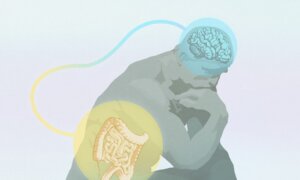On Oct. 11, 2002, in Lafayette, Louisiana, Bruce Leininger was cleaning up his yard in the aftermath of Hurricane Lili. Taking a moment to rest, he sat down with his four-year-old son, James, and cradled him in his lap. Hugging him, Bruce told James, “You are such a good son.”
James looked up at his father and replied: “That’s why I picked you. I knew you would be good parents.”
This may sound like the musings of a child, but the remainder of the conversation perplexed Bruce.
“Where did you find us?” Bruce asked.
“A big pink hotel in Hawaii,” James answered.
“What were we doing when you picked us?” Bruce asked.
“You were having dinner on the beach at night,” James stated matter-of-factly.
Bruce and his wife, Andrea, were astonished. From late May to early June 1997, they celebrated their fifth wedding anniversary at the Royal Hawaiian, a coral-pink hotel in Honolulu. There, indeed, they enjoyed dinner on the beach at night.

The Royal Hawaiian Hotel, a beachfront luxury hotel in Honolulu on the island of Oahu, Hawaii. (Source: Frank Schulenburg, CC BY-SA 4.0)
The experience was personal, one they had never discussed in front of James. Furthermore, the trip occurred four to five weeks before Andrea became pregnant. There was no way James could have known these intimate details.
These conversations were recorded in “Consciousness Survives Physical Death,” a prize-winning article submitted to the Bigelow Institute, sponsored by Bigelow Aerospace and owned by Robert Bigelow.
James’s recollections didn’t end with choosing his parents. He is one of many children with memories beyond this life. A large body of research suggests that consciousness carries memories from life to life.
A World War II Pilot
Since birth, James had an unusual fascination with airplanes.
At the age of 2, he began having nightmares of a plane crash, where he described himself as an American pilot whose plane was shot down by the Japanese.
James provided details that included the name of the aircraft carrier, the name of the friend on the ship with him, and the location and specific details of the crash. The details corresponded to the death of World War II pilot James McCready Huston Jr.
Moreover, James knew specific, historically accurate details that neither his parents nor the general public would have known. At the age of two, he identified the ship’s name, the USS Natoma Bay, where Huston’s plane flew from, as well as a fellow pilot, Jack Larsen.
Huston’s family also verified little James’s statements about his claimed previous personal life. For example, he knew Huston’s nickname for his sister, which only her deceased brother—James Huston—had used.
Dr. Jim Tucker, a psychiatrist from the University of Virginia who reported the case in a 2016 paper, concluded: “On the face of it, the most obvious explanation for this connection is that he experienced life as James Huston, Jr. before having his current one. The facts in the case indicate that this explanation warrants serious consideration.”
The phenomenon of past life memories (PLM) is regarded in some Asian religions and philosophies as reincarnation, which refers to the rebirth of consciousness after bodily death.
During the past century, more and more scientists have become interested in this topic.
Prominent scientist Carl Sagan, founding member of the Committee for the Scientific Investigation of Claims of the Paranormal, wrote in his book, “The Demon-Haunted World,” “There are three claims in the ESP [parapsychology] field which, in my opinion, deserve serious study.”
The third was “that young children sometimes report details of a previous life, which upon checking turn out to be accurate and which they could not have known about in any other way than reincarnation.”
2,500 Cases: ‘Data That Cannot Be Ignored’
The discussion about past life memory has extended beyond religion to the scientific field.
Dr. Ian Stevenson (1918–2007), a chairman of the Department of Psychiatry and Neurology at the University of Virginia, was the first medical professional to push the boundaries of reincarnation research.
In a contest by the American Society for Psychical Research, which studies paranormal mental phenomena, Stevenson chose to analyze 44 people with memories of past lives. His paper won first place.
While conducting his research, he was struck by the similarities in cases from different countries and sources and felt compelled to investigate further.
Stevenson went on to dedicate more than 30 years to systematically studying the phenomenon of past life memories. He collected and meticulously documented in his book, “Reincarnation and Biology,” more than 2,500 cases of children worldwide who claimed to remember past lives.
One of his studies, published in Medical Hypotheses, involved 856 cases of PLM, of which 67 percent were marked as solved. According to Stevenson’s methodology, a “solved” case means researchers identified a deceased individual whose life and death details precisely matched the child’s recounted memories.

In a study conducted by Ian Stevenson from the University of Virginia, 67 percent of the 856 cases of claimed past life were identified. (The Epoch Times)
Stevenson’s research encompassed diverse regions, including India, Sri Lanka, Turkey, Lebanon, Thailand, Myanmar, and countries in North America, South America, and Europe.
He focused his studies on children for two reasons. First, young children were less likely to fabricate past-life memories with a high level of verifiable detail. Second, they typically had limited exposure to external sources of information, making it improbable they could have acquired detailed knowledge about deceased individuals through ordinary means.
His articles outline each step of his process and invite readers to scrutinize his methods and results.
Stevenson was a prominent scientist credited with about 60 publications in mainstream medical society. His methods of research are widely respected as a role model for studying past life memory cases. Stevenson’s contributions earned him the title of “chair professor,” a distinction awarded to particularly eminent scholars.
“He has painstakingly and unemotionally collected a detailed series of cases,” Dr. Lester S. King commented on Stevenson’s research in a 1975 article in JAMA. “He may not convince skeptics but [Stevenson] has placed on record a large amount of data that cannot be ignored.”
Dr. Emily Kelly, a long-time colleague of Stevenson, wrote in a 2007 article in the BMJ, “[Stevenson] believed the evidence was sufficient to permit a reasonable person to believe in reincarnation.”
One such example of evidence—that drew the attention of Mahatma Gandhi—is that of Shanti Devi in India.
A Case That Captivated Gandhi
Shanti Devi was a girl who lived in Delhi since her birth in 1926. When she was three years old, she began recalling her past life as a woman named Lugdi. Initially, her parents dismissed her vivid memories as childish fantasies.

Shanti Devi began recalling her past life memories at the age of three. (Source: John H. Manas, CC BY-SA 4.0)
As Devi grew older, she insisted on visiting her former husband, Kedar Nath, in Mathura, 162 kilometers away. Their curiosity piqued, her family located and wrote to Nath, who eventually visited Devi. To his astonishment, the 9-year-old girl accurately identified him and other relatives, recounting details of their lives that she could not have possibly known.
The media report on Devi drew the attention of Mahatma Gandhi. When Devi was 10, Gandhi established a “committee of inquiry” comprising 15 distinguished members—including lawyers, journalists, political leaders, and congressional members—to investigate the claims.
The committee affirmed that Devi had never left Delhi. They later accompanied her to Mathura, where she correctly identified Nath’s house and her father-in-law’s house and described its layout.
Furthermore, Devi pointed to a corner of the room where she claimed to have buried money. When witnesses excavated the area, they uncovered a case meant for storing valuables, but it was empty. Devi insisted she had left money there, and eventually, Nath acknowledged that he had found and taken the money after his wife’s death.
Stevenson noted that at least 24 of her claims were confirmed—compelling evidence that her memories were not fabrications.
Ultimately, the committee published a 26-page report in 1936, concluding that Devi was a rebirth of Lugdi. The case was also featured in the Dec. 12, 1937, issue of American Weekly.
Impossible Knowledge
According to Stevenson, a typical child case of past-life memory usually arises between the ages of 2 and 4 years. These children spontaneously relate details of past lives, even if they are thousands of miles away from where they occurred, and the events happened a dozen years or more prior. These details are often as much as 90 percent accurate.

According to Ian Stevenson, details of past lives recounted by children were 90 percent accurate. (The Epoch Times)
This sign of reincarnation involves “talking about things that there is absolutely no way in the world these kids could know at that age,” Carol Bowman, a past-life regression therapist who has been investigating PLM in American families for 35 years, told The Epoch Times.
These children usually have no psychosocial problems, Bowman said. Their past lives are often of ordinary families rather than renowned people or celebrities, so there is a lack of motive to fabricate stories.
Bowman described a three-year-old girl named Megan who talked about her past life as a man (John) whose wife (Mary) died of “the consumption,” a common term for tuberculosis in the 1800s. Megan also said that because of Mary’s sickness and inability to give birth to a child, she was very sad. How could this little girl learn medical knowledge regarding consumption and infertility during the course of her current young life?
Children who remember past lives can often show an unlearned skill. Devi naturally spoke the local language in Mathura, where she had lived in her previous life, even though she had never been there and had not learned it in her life.
Bowman reported that a 4-year-old American boy, Tommy, had expertly sewn a button on his pants. When his mother asked where he learned the skill, the boy replied, “Well, we used to do it on my ship all the time,” and he started to describe his past life as a sailor.
“They shift into a very serious way of expressing themselves, very matter of fact, serious, adamant that what they are saying is true,” Bowman said.
A systemic review published in 2021 analyzed 78 observational studies and found that of those children with past-life memory, 23 percent had unlearned skills. More surprisingly, 37 percent had birthmarks or defects matching wounds from previous lives.
Birthmarks are common—so how can a birthmark connect a past life with the current one?
Birthmarks and Defects–Coincidental?
In a study of 895 children with past life memories, 35 percent had unusual birthmarks or congenital defects, according to Stevenson.
Stevenson’s research indicates a significant consistency rate of 88 percent between wounds and birthmarks in past life cases supported by postmortem reports or other confirming documents.
For example, in one case, a Turkish boy had a malformed right ear. The boy remembered being shot on the right side of his skull in a previous life. Stevenson identified the past life and confirmed the cause of death by reviewing hospital records.
Bowman has also collected evidence related to birthmarks and behaviors. For instance, Kathy’s first child, (also named) James, tragically passed away from neuroblastoma shortly after his second birthday. James had problems with his left eye, right ear, and left leg, and an intravenous injection left a scar on his neck.
Twelve years after James’s death, Kathy’s other son, Chad, was born. Chad began to show striking physical similarities to James. Chad experienced blindness in his left eye, had a problem with his right ear, faced a disability in his left leg, and bore a scar in the exact same spot on his neck as James.
Moreover, Chad shared a quiet and nervous demeanor similar to James’s. At four years old, Chad started claiming he lived in a house with chocolate-colored furniture and played with certain toys, perfectly matching every detail of James’s life.
Postmortem reports and medical records confirm that the means of death in a previous life are consistent with current birthmarks, which is beyond coincidence.
Floated Explanations
Alternative explanations for past-life memories include memory distortions, parental influence, and cultural or social conditioning. However, these hypotheses have weaknesses.
A 2007 study suggested that past life memories appeared to be caused by confusion in memory or false memories. However, confusion in memory cannot explain the accuracy and verifiable details demonstrated in many well-documented cases by researchers.
Moreover, studies have shown that the initial attitude of mothers toward past-life memories of their children varied. Overall, 51 percent of mothers were neutral or tolerant of past life memories, 28 percent were discouraging, and 21 percent were encouraging.
Some attribute birthmarks to the child’s mother’s maternal impression. They state that a pregnant woman’s awareness of a deceased person’s wounds could influence the developing embryo and fetus, resulting in physical characteristics that correspond to those wounds.
According to Stevenson’s research, the children’s mothers usually did not know about their past life’s wounds. The hypothesis also couldn’t explain how the mother’s thoughts could modify her unborn child’s body or why the children would have those memories.
For the cultural or social conditioning hypothesis, the 2021 systemic review found that PLM cases were not only reported in countries from Asia that have cultural and religious reincarnation beliefs but also in America and Europe, suggesting a cross-cultural phenomenon.

PLM cases have been reported in countries around the world, suggesting a cross-cultural phenomenon. (The Epoch Times)
Other people explain PLM as coincidental events—that a birthmark or defect occurs by chance—and the person subsequently learns about a deceased individual with a similar mark. The similarity causes them to feel connected to that person. However, there is no solid evidence, and it appears unlikely, especially considering most PLM cases involve children.
Skeptics often dismiss birthmarks or defects as indicators of past lives as mere coincidence.
How many coincidences need to occur to substantiate a single case PLM when documented facts align with the memories expressed? The more detailed and verifiable the connections are, the harder it becomes to dismiss such claims as coincidence.
Dr. Eben Alexander is a renowned neurosurgeon who has studied the brain for decades and himself had a near-death experience.
In a previous interview, he told The Epoch Times, “I would say our human consciousness can be quite limited because of our prejudices and assumptions when we think we understand things but are not paying attention to all the evidence.”
Past-Life Regression
When people have a traumatic memory in an earlier stage of their current lives, it can have implications for their physical or mental health, often contributing to post-traumatic stress disorder (PTSD). Psychologists may use talk therapy to help patients release the traumatic injury in their bodies to heal mentally and physically. Such psychotherapeutic approaches complement pharmacologic treatment prescribed by a psychiatrist.
Similarly, some health practitioners have explored past-life regression therapy, a type of hypnotherapy, to treat diseases. Similar to the treatment of PTSD, past-life regression therapy relies on guided dialogue under hypnosis, with the therapist helping the patient explore what they believe are memories from past lives.
While there is ongoing debate surrounding the robustness of the efficacy of past-life regression therapy, there are documented patients who have benefited from this treatment.
Jason Liu, a holistic health practitioner in California with a doctorate in neuroscience, told The Epoch Times that he witnessed one patient with fibromyalgia who recovered a normal life after past life regression therapy.
Marilyn, a 46-year-old woman, had been suffering from constant, debilitating chronic pain for years, which led her to attempt suicide. In addition to fibromyalgia, she struggled with coexisting conditions, including chronic fatigue syndrome, anxiety, depression, and insomnia.
Though her husband was a medical doctor, conventional treatment didn’t help her. Liu decided to try past life regression therapy.
Under hypnosis using theta brainwaves, Marilyn entered a peaceful trance state. In the hypnotic state, she accessed a fragment of memory indicating she was a soldier in a war and under attack. Through a series of conversations with Liu, she came to understand that the intense fears she had experienced in her past life were linked to the physical pain she was enduring in her present life.
With Liu’s gentle guidance, Marilyn was able to separate the emotional trauma of her past life from her current reality. Since then, she has felt significantly more at peace and hopeful. Her physical and mental symptoms improved dramatically, leading to a full recovery.
Bowman’s son also had past life memories. He developed chronic eczema and a phobia of loud noises when he was five years old.
“When we asked him what this was about, he proceeded to tell us, in first person account, that he had been a soldier and he was killed on a battlefield behind a cannon,” Bowman said.
After her son talked about his past life memory, his physical condition of chronic eczema disappeared, and his phobia of loud noises went away.
“There is some [kind of] body memory, somatic memory, related to these memories,” Bowman said, suggesting that the past life may be stored in our consciousness and body.
Flowing River
A river transports sand, nutrients, and aquatic life as it flows gracefully from the peaks of the mountain to its destination. Similarly, studies related to past life memories suggest that our consciousness is like a flowing river, carrying memories, experiences, and the essence of our souls from one life to the next, connecting us to the tapestry of existence.
“I think [it] is fascinating because, as Ian Stevenson [talked] about too—our current situations, our current personalities, can have origins in past life experience,” Bowman told The Epoch Times.
“Consciousness survives death as well as personality traits, feelings, and physical traits. This transfers over to another body, another life, different circumstances, but it’s all connected. There’s a continuum from one life to another.”
After Stevenson passed away, his successor, Dr. Jim Tucker, a Bonner-Lowry professor of psychiatry and neurobehavioral sciences and the director of the Division of Perceptual Studies at the University of Virginia, continued his mission to study PLM.
Dr. Brian L. Weiss and Dr. Bruce Greyson also work on past life memory research. Weiss is a renowned psychiatrist, a graduate of Columbia University and Yale Medical School, and chairman emeritus of psychiatry at the Mount Sinai Medical Center in Miami. Greyson is a professor emeritus of psychiatry and neurobehavioral sciences at the University of Virginia.
The accumulation of evidence in the first three articles of this series alludes to the possibility that consciousness extends beyond our physical reality.
Everyone eventually dies. However, if our consciousness is eternal and memories of our past life experiences persist, it could potentially hold significant meaning for our well-being in this life and in the future.
If memories can traverse lifetimes, it raises the question: Where does our consciousness reside amid different lives? Where is the initial origin or ultimate home of our consciousness?
Next, we will continue to explore the potential origin of consciousness in light of multiple lines of scientific research.














